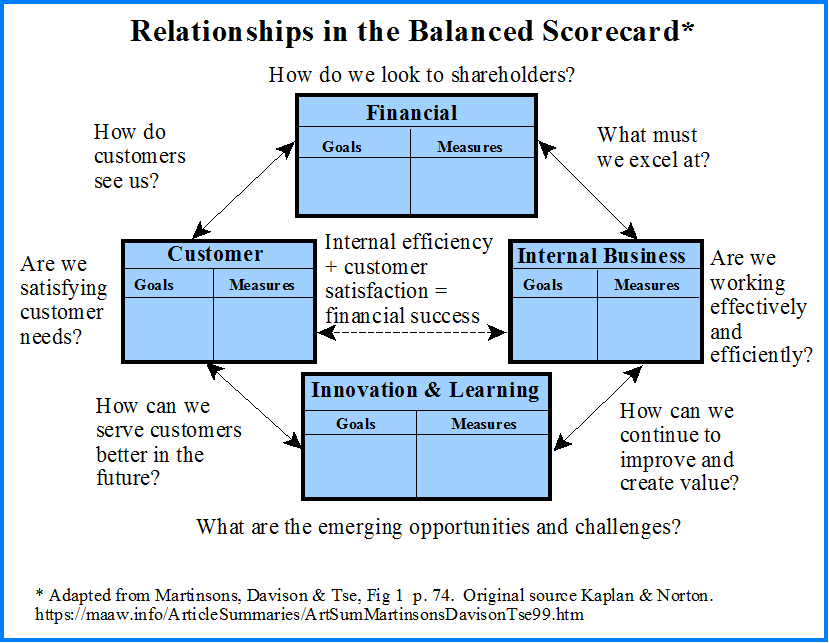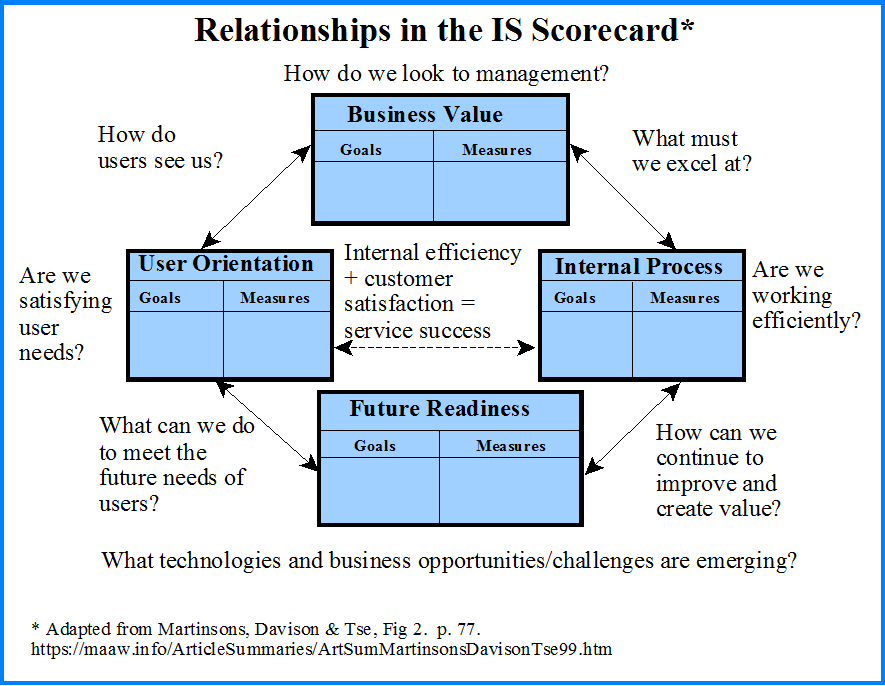
Summary by Eileen Z. Taylor
Ph.D. Program in Accounting
University of South Florida, Spring 2004
AIS/MIS Main Page | Balanced Scorecard Main Page |
Strategy Related Main Page
The productivity paradox is a major issue at the crux of accounting and information systems. On the one hand, millions of dollars have been invested in Information Technology; however, this investment cannot be linked to concomitant increases in productivity or profit. Are these investments cost beneficial? If they are, why can’t we see the evidence?
There are two reasons given for this paradox. First, it may be related to how we measure productivity and profit. Many investments in IT provide intangible benefits; ones that resist traditional measurement techniques. Second, it is thought that the full potential of these improvements is not being realized because business processes are not being changed to meet the changes in IT. In other words, these improvements are underutilized.
The authors suggest that Kaplan and Norton’s Balanced Scorecard (BSC) approach can be modified to address the mismeasurement issue. The BSC has been developed as a way to both communicate business strategy, as well as direct attention to drivers of financial success. The traditional BSC divides performance into four perspectives: financial, customer, internal process, and learning and growth. The authors propose that the BSC can be revised so that it becomes a useful way to measure IT project success. The following graphic illustrates the balanced scorecard framework and the relationships between perspectives.

Evaluating business functions, departments and projects
The authors first undertake an explanation of critical differences between IT departments and other general business functions. They note that IS departments are typically internal to the organization, their product serves both the users, as well as the organization (there are no external customers). Also, they feel that the value of IT must be considered from a top-down approach. Based on the mainstream IS literature, they modify the original BSC to fit within an IS context. The revised scorecard framework illustrated below provides a graphic view of their modifications.

The four new perspectives that are identified include: user orientation, business value, internal process, and future readiness. Table 3 provides a listing of each perspective, its mission, key question, and objectives.
The user orientation perspective is an end-users’ view and seeks to develop an ongoing relationship with end-users (customers).
The business value perspective is management’s view. This perspective is concerned about the contribution of IS to the entire organization. It also has a focus on cost control and establishing a continuing relationship with management.
The internal processes perspective is an operations-based view. It’s objective centers on efficiency and effective management of issues.
The future readiness view is similar to the learning and growth perspective. It emphasizes innovation and learning. Objectives focus on upgrading hardware and software, updating IT application, and build IS skills through employee training.
Measuring and Evaluating Business Value
The paper identifies several approaches to measuring value. The most traditional is to use budgets. Benchmarking is also noted. However, value is a broader concept. The authors note that the value of a single IT project is often interrelated with other projects such that they are complementary. Both need to be undertaken for value to be created.
The information economics method is also described as a way to measure value, while considering risk. The exact process is explained further within the text. However, it is important to note that this method allows joint assessment by all parties involved (end-users, developers, management). Value linking, value acceleration, value restructuring, and strategic IS architecture are also mentioned.
Measuring and evaluating user orientation
Unlike in other businesses, the market of the IS department consists of internal end-users. Therefore, ideas like market growth and market share are not applicable. However, it is important to develop a good relationship with the end users, les they go elsewhere for their IT needs. Therefore, satisfaction of current customers is a key. Trust is also a key factor.
Measuring and evaluating internal processes
Internal operations center on planning and prioritization of projects, development of new IT applications, and operation and maintenance of current IT applications. (p.80). The goal throughout is high quality and low cost. The problem with measuring IT success is the lack of a standard set of measurements. The authors suggest measuring “lines of code” and “function points” as possible solutions.
This section also addresses ways to increase demand. This can be done by “finding new customers for existing services or providing additional services to existing customers.”(p.81)
Measuring and evaluating future readiness
There are three components to this perspective. They include: improving employee’s skills, updating applications, and researching emerging technologies. Development of knowledge management systems and artificial intelligence programs are both ways to improve future readiness. Environmental scanning is also critical so that the department can adapt to new trends.
Building a balanced IS scorecard
There are 7 steps involved with building a balanced IS scorecard. They include:
Introducing the BSC method to management.
Collecting and analyzing data on strategy, objective, and metrics.
Defining objectives based on the four perspectives.
Developing a preliminary BSC.
Soliciting comments and feedback.
Achieving a consensus.
Communicating the final BSC to all parties.
Cause and effect / Performance Drivers
Cause and effect relationships should be well defined among the four perspectives. Additionally, the measures should include a mix of both outcome measures as well as performance drivers. These need to be linked to financial measures.
The new monitoring system should be continuous – managers should be able to see how a change in one perspective affects the other perspectives.
Case Studies – Practical notes
The authors studied the implementation of a BSC approach in three Hong Kong companies. They identified three problems (p.84):
1. No specific long-term objectives.
2. No identification of cause and effect.
3. No communication of the BSC rationale and contents.
Future readiness was identified as a perspective that suffered from lack of long-term objectives. Also, internal process goals were not seen as challenging or specific to overall goals. Modification is suggested. Finally, successful implementation requires communication of explicit cause and effect relationships. This communication was non-evident in the case studies. In addition, individual performance evaluations and rewards were not linked to the BSC objectives. Thus, managers may have been unmotivated to adhere to the BSC.
Overall, more research needs to be done on BSC implementation in an IS setting.
_______________________________________________
Related summaries:
Bensaou, M. and M. Earl. 1998. The right mind-set for managing information technology. Harvard Business Review (September-October): 119-128. (Summary).
Davenport, T. H. 1998. Putting the enterprise into the enterprise system. Harvard Business Review (July-August): 121-131. (Summary).
Elliott, R. K. 1992. The third wave breaks on the shores of accounting. Accounting Horizons 6 (June): 61-85. (Summary).
Epstein, M. J. and J. Manzoni. 1997. The balanced scorecard and tableau de bord: Translating strategy into action. Management Accounting (August): 28-36. (Summary).
Kaplan, R. S. and D. P. Norton. 1992. The balanced scorecard - Measures that drive performance. Harvard Business Review (January/February): 71-79. (Summary).
Kaplan, R. S. and D. P. Norton. 1993. Putting the balanced scorecard to work. Harvard Business Review (September-October): 134-147. (Summary).
Kaplan, R. S. and D. P. Norton. 1996. The Balanced Scorecard: Translating Strategy into Action Boston: Harvard Business School Press. (Summary).
Kaplan, R. S. and D. P. Norton. 1996. Using the balanced scorecard as a strategic management system. Harvard
Business Review (January-February): 75-85. (Summary).
Kaplan, R. S. and D. P. Norton. 1997. Why does business need a
balanced scorecard? Journal of Cost Management (May/June): 5-10. (Summary).
Kaplan, R. S. and D. P. Norton. 2000. Having trouble with your strategy? Then map it. Harvard Business Review (September-October):
167-176. (Summary).
Kaplan, R. S. and D. P. Norton. 2001. The Strategy-Focused Organization: How Balanced Scorecard Companies Thrive in the New Business Environment.
Harvard Business School Press. (Summary).
Kaplan, R. S. and D. P. Norton. 2001. Transforming the balanced scorecard from performance measurement to strategic management: Part I.
Accounting Horizons (March): 87-104. (Summary).
Kaplan, R. S. and D. P. Norton. 2001. Transforming the balanced scorecard from performance measurement to strategic
management: Part II. Accounting Horizons (June): 147-160. (Summary).
Kaplan, R. S. and D. P. Norton. 2004. Measuring the strategic readiness of intangible assets. Harvard Business Review (February): 52-63. (Summary).
Lipe, M. and S. Salterio. 2000. The balanced scorecard: Judgmental effects of common and unique performance measures. The Accounting Review (July): 283-298. (Summary).
Lipe, M. G. and S. Salterio. 2002. A note on the judgmental effects of the balanced scorecard's information organization. Accounting, Organizations and Society 27(6): 531-540. (Summary).
Martin, J. R. Not dated. Balanced scorecard concepts. Management And Accounting Web. Bal Score Sum
Paladino, B. 2007. 5 key principles of corporate performance management: How do Balanced Scorecard Hall of Fame, Malcolm Baldrige, Sterling, Fortune 100, APQC, and Forbes award winners drive value? Strategic Finance (June): 39-45. (Note).
Roberts-Witt, S. L. 2002. Data mining: What lies beneath? Finding patterns in customer behavior can deliver profitable insights into your business. PC Magazine (November, 19): iBiz 1-6. (Summary).
Williams, S. 2011. 5 Barriers to BI success and how to overcome them. Strategic Finance (July): 26-33. (Note).